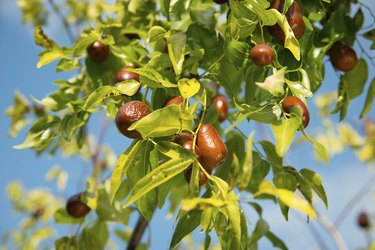
A jujube tree (Ziziphus jujube) is sometimes referred to as a juju berry tree, which is a slang term for the tree. The jujube tree belongs to the Rhamnaceae family and is sometimes called a Chinese date tree. It is a small, deciduous tree that produces a cherry- to plum-size edible fruit, hence the words "berry" and "date." It is hardy in U.S. Department of Agriculture plant hardiness zones 6 to 9.
Origin
Video of the Day
The jujube tree originated in China, where there are more than 400 cultivars. It has been cultivated there for more than 4,000 years. Centuries ago, the trees were taken beyond Asia to different parts of the world, including the southwestern United States, but in many cases they developed into substandard strains. In 1908, improved Chinese varieties were brought to the United States by the USDA.
Video of the Day
Growing Conditions
The jujube grows well in different climates. It withstands a range of temperatures and is heat tolerant. A lack of summer heat and sun may limit fruit production, so avoid planting them in the shade of other trees. The jujube tree is dormant in winter, allowing it to withstand temperatures to about negative 28 degrees Fahrenheit. Jujubes tolerate many types of soils, even those with high salinity or alkalinity. Still, they grow best in sandy, well-drained soils and do not do as well in heavy, water-logged soils. Jujube trees can be grown in a large containers but are not particular suited for container culture.
Foliage and Flowers
The leaves of the jujube tree are small, are ovate or oval and measure 1 to 2 inches long. They are a shiny, bright green. On the base of each leaf are two spines, which are either hooked or shaped like long daggers. Some cultivars are nearly thornless. The nodes of the branches produce one to 10 branchlets throughout a growing season, many of which fall from the tree in autumn. Flowers are produced in the leaf axils over several months from late spring into summer. They are small, white to greenish yellow and somewhat fragrant. Pollination appears to be done by ants, insects or the wind, but individual flowers are receptive to pollen for no more than a day.
Fruit
Most jujube cultivars produce fruit without cross-pollination. The fruit on some cultivars ripen as early as October, with others ripening from mid-February to the end of April. Depending on the cultivar, the fruit ranges from cherry size to plum size and varies in shape from round to elongated. The skin is thin and edible, and the flesh is whitish and sweet. There is a single, hard center that contains two seeds. Young fruit is green, but as it ripens it changes to a yellow-green with mahogany-colored spots and eventually turns entirely red. Shortly after becoming red, the fruit softens and becomes wrinkled. It is usually eaten between the yellow-green stage or after turning red and wrinkling. Some cultures use the fruit medicinally, with one of its most popular uses as a tea for a sore throat.